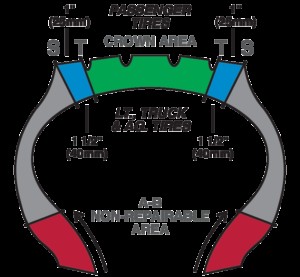Dealing with a flat tyre is an inevitable part of driving. While emergency roadside repairs like tyre plugs and string repairs might seem like quick fixes, it’s crucial to understand they are only temporary solutions. These methods are designed to get you to a safe location or a professional service centre for a proper tyre repair. Many drivers mistakenly believe that if a plug or string repair holds air, it’s a safe, permanent fix. However, this isn’t the complete picture. These temporary repairs often fail to completely seal the puncture, allowing air and moisture to seep into the tyre’s structure. Over time, this can lead to internal damage and potentially a dangerous tyre blowout.
Why Patch-Only Repairs Are Also Insufficient
Similarly, relying solely on a patch for a tyre repair is also considered inadequate and unsafe. Although a patch effectively seals air from escaping, it doesn’t address the puncture channel itself. Just like plug-only repairs, a patch alone leaves the injury open to contamination from the outside. Moisture and air can still penetrate through the tread, potentially causing hidden damage within the tyre over time.
The Industry-Standard Proper Tyre Repair Process
According to industry guidelines, a proper tyre repair requires a combination of a patch and plug to completely seal the puncture from the inside out, including the entire injury channel. This comprehensive approach involves several essential steps, which can be easily remembered using the acronym R.E.P.A.I.R.:
-
Remove: The first step is to remove the tyre from the wheel. This allows for a complete and thorough inspection of both the interior and exterior of the tyre to accurately assess the damage.
-
Evaluate: With the tyre removed from the wheel rim, you can properly evaluate the puncture. This involves determining the size, direction, and angle of the injury. Crucially, this step also allows you to check for any significant damage to the tyre’s internal components like cords or belts.
-
Prepare: Once you’ve confirmed that the tyre is suitable for repair, preparation is key. This stage involves preparing the rubber surfaces to ensure optimal adhesion of the repair materials. Firstly, use a carbide cutter to carefully drill out the injury channel. This removes any damaged cords, belts, and debris from the puncture path. Next, clean and buff the inner liner around the puncture area to create a slightly rough texture. This roughened surface is essential for maximizing the adhesion of the patch/plug repair unit.
-
Apply: The next step is the application of vulcanizing fluid. Apply this fluid generously through the prepared injury channel and also to the buffed area on the inner liner. Allow the vulcanizing fluid to air dry for approximately 5 to 10 minutes. This drying time is critical for the vulcanizing process to initiate properly.
-
Install: Now it’s time to install the combination repair unit. This typically involves a one-piece or two-piece patch/plug unit. Carefully insert the plug portion of the repair unit through the injury channel from the inside of the tyre. Then, firmly apply the patch portion to the prepared and vulcanized inner liner. Use a tire stitcher, a specialized rolling tool, to thoroughly stitch the patch down to the inner liner. This step is crucial for removing any trapped air bubbles and ensuring a complete and airtight seal. After stitching, treat the over-buffed area with a thin layer of rubber sealant for extra protection. Finally, trim any excess repair material extending beyond the tread surface, leaving approximately ¼” above the tread.
-
Return to Service: The final step is to get the tyre back in service. Remount the repaired tyre onto the wheel rim. Inflate the tyre to the correct pressure, balance the wheel and tyre assembly, and then remount the wheel back onto the vehicle. Your tyre is now properly repaired and ready to get back on the road.
 the repairable are of most tires is restricted to the crown
the repairable are of most tires is restricted to the crown
Is Your Tyre Repairable? Key Factors to Consider
Before attempting any puncture repair, it’s important to determine if your tyre is actually safe to repair. Several factors come into play, falling into three main categories:
-
Injury Location: For standard passenger car tyres, repairs are only considered safe if the puncture is located within the crown area of the tyre. Damage to the shoulder or sidewall areas is in a critical flex zone and therefore deemed non-repairable.
-
Puncture Size Limitation: The size of the puncture is also critical. For fabric-ply passenger and light truck tyres, the maximum allowable puncture size for repair is ¼” (6mm). For steel-belted light truck tyres, as well as medium and heavy-duty truck tyres, a slightly larger puncture size of up to 3/8” (10mm) may be repairable.
-
Overall Tyre Condition: The general condition of the tyre is paramount. Even if the puncture meets the location and size criteria, pre-existing tyre conditions can make it unsafe to repair. Conditions such as excessive tyre wear, casing separation, previous impact damage, and other forms of significant tyre degradation can compromise the integrity of the repair and the tyre itself. For a more detailed guide on determining tyre repairability, you can consult resources like “Can Your Tire Be Repaired?” which offers a comprehensive overview of repairable versus non-repairable tyre conditions.
Conclusion: Prioritise Proper Tyre Repair for Safety
Experiencing a flat or slow-leaking tyre is a common and frustrating part of vehicle ownership. However, when it comes to repairs, taking shortcuts can have serious safety implications for you and your passengers. Investing the time to understand and perform a proper puncture repair, or seeking out a reputable tyre repair shop that adheres to industry-standard procedures, is always the safest and most responsible course of action. Ensuring your tyres are correctly repaired is crucial for maintaining vehicle safety and preventing potential hazards on the road.

